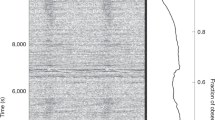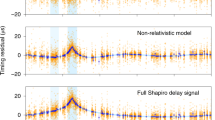Abstract
An extensive pulse timing programme has been carried out over the past 10 years for several pulsars1–5. The timing observations revealed a wide range of different effects such as glitches, noise in the pulsar rotation and unexpectedly large second time derivatives of the rotation frequency. We suggest here that these unexpectedly large values of v̈ may be caused by a binary motion with an orbital period, Pb, longer than the span of timing observations. Even a distant planet of a relatively low mass (100 M⊕ for Pb = 50 yr) would influence v̈. In the case of PSR0329+54, besides a large v̈ term, a quasi-sinusoidal modulation shows up in timing residuals. This 3-yr periodicity may be caused by: (1) a change in pulse shape, (2) precession of a magnetic dipole axis, or (3) a small planet (m = 0.06 − 0.57 M⊕) orbiting the pulsar.
This is a preview of subscription content, access via your institution
Access options
Subscribe to this journal
Receive 51 print issues and online access
$199.00 per year
only $3.90 per issue
Buy this article
- Purchase on Springer Link
- Instant access to full article PDF
Prices may be subject to local taxes which are calculated during checkout
Similar content being viewed by others
References
Gullahorn, G. E. & Rankin, J. M. Astr. J. 83, 1219–1224 (1978).
Taylor, J. H., Fowler, L. A. & McCulloch, P. M. Nature 277, 437–440 (1979).
Gullahorn, G. E., Isaacman, R., Rankin, J. M. & Payne, R. R. Astr. J. 82, 309–312 (1977).
Groth, E. J. Astrophys. J. Suppl. Ser. 29, 431–466 (1975).
Helfand, D. J., Taylor, J. H., Backus, P. R. & Cordes, J. M. Astrophys. J. (submitted).
Manchester, R. N. & Taylor, J. H. Pulsars (Freeman, San Francisco, 1977).
Cordes, J. M. Astrophys. J. (submitted).
Cordes, J. M. & Helfand, D. J. Astrophys. J. (submitted).
Baym, G., Pethick, C., Pines, D. & Ruderman, M. Nature 224, 872–874 (1969).
Pines, D., Shaham, J. & Ruderman, M. Nature phys. Sci. 237, 83–84, 96 (1972).
Manchester, R. N., Hamilton, P. A., Goss, W. M. & Newton, L. M. Proc. Astr. Soc. Austr. 3, 81–83 (1976).
Gullahorn, G. F. & Rankin, J. M. Bull. Am. Astr. Soc. 9, 562 (1978).
Smith, F. G. Pulsars (Cambridge University Press, 1977).
Lamb, D. Q. & Lamb, F. K. Astrophys.J. 204, 168–186 (1976).
Author information
Authors and Affiliations
Rights and permissions
About this article
Cite this article
Demiański, M., Prószyński, M. Does PSR0329 + 54 have companions?. Nature 282, 383–385 (1979). https://doi.org/10.1038/282383a0
Received:
Accepted:
Issue Date:
DOI: https://doi.org/10.1038/282383a0
This article is cited by
-
Toward planets around neutron stars
Astrophysics and Space Science (1994)
-
Planets around pulsars: A review
Astrophysics and Space Science (1994)
-
A planetary system around the millisecond pulsar PSR1257 + 12
Nature (1992)
Comments
By submitting a comment you agree to abide by our Terms and Community Guidelines. If you find something abusive or that does not comply with our terms or guidelines please flag it as inappropriate.



